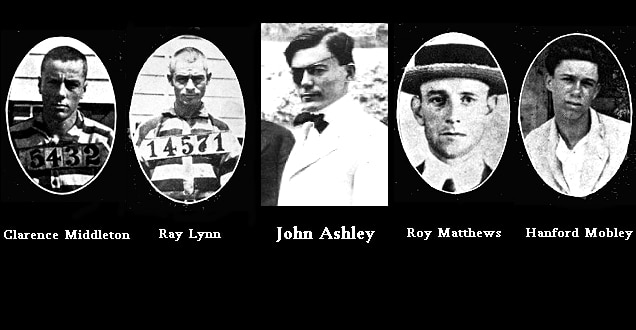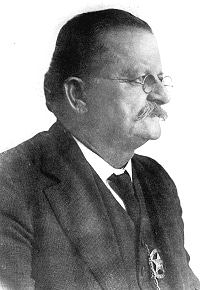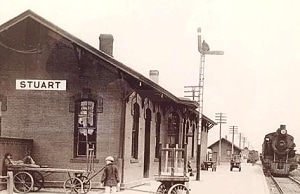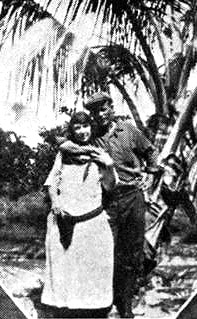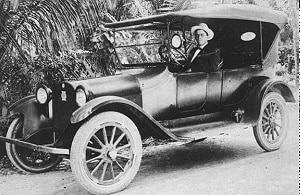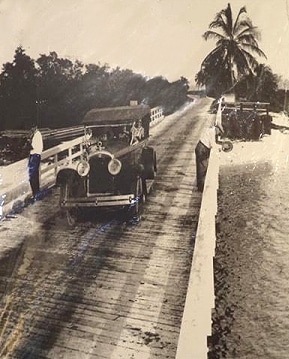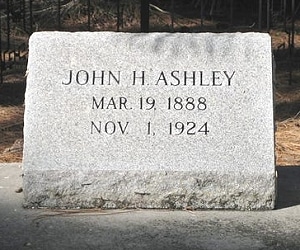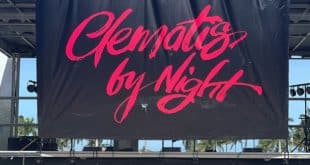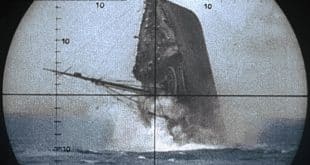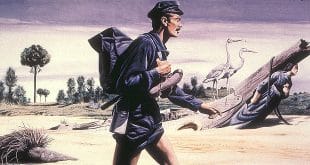How terrifying were the Ashley Gang? Between 1915 and 1924, they robbed over forty banks. One Florida official said they were the greatest threat to the state since the Seminole Indian Wars. Their appetite for revenge was insatiable. No matter how long it took, once you crossed them they would relentlessly track you down from their base deep inside the Florida Everglades.
The gang’s father, Julius Warren “Joe” Ashley, moved to West Palm Beach in 1911 with is wife Lugenia Clay Ashley where he served briefly as a lawman and worked on building Henry Flagler’s railroad. He was also a first-rate moonshine distiller. The family eventually settled in Gomez, two miles north of Hobe Sound in Palm Beach County (Martin County, where the area is located today, wasn’t created until 1925). Joe was a former backwoodsman who had nine children and taught his five sons (Bill, Bob, Ed, Frank and John) how to trap otters and hunt alligators in the Everglades. They eventually knew their way through the swamp as well as the local Seminoles.
In January 1912, John Ashley was accused of murdering Seminole trapper Desoto Tiger, the son of Tommy Tiger, chieftain of the Cow Creek Seminoles and a veteran of the Third Seminole War. Desoto’s body was discovered on December 29, 1911 by a crew dredging the New River Canal from Fort Lauderdale to Lake Okeechobee. He had been shot in the back and was last seen alive with John in a canoe full of otter pelts. Furthermore, a receipt for the sale of eighty-four otter pelts for $1,200 to the Girtman Brothers trading post in Miami was signed J. Ashley.
Palm Beach County Sheriff George B. Baker, the county’s first sheriff, dispatched two deputies to arrest John at his swamp camp in Gomez. They had no sooner arrived when a voice hidden in the thick palmetto bushes commanded them to stop in a thick Southern drawl.
“Hold it right there, boys. Put down them rifles. Put up your hands and step in here. Move real easy.”
The deputies dropped their guns and cautiously stepped into a clearing to see John and his brother Bob, the most vicious of the Ashley boys, huddled over a camp fire brewing coffee.
“I’m gonna let you go ’cause I want you to deliver a message,” John said, not bothering to look up. “Tell Sheriff Baker not to send any more chicken-hearted men with rifles or they are apt to get hurt.”
The deputies beat a hasty retreat and John Ashley’s photo was tacked inside every post office in South Florida. There was nowhere he could go in public without being recognized, so he fled the state to New Orleans. Two years later, John Ashley was homesick and surrendered to Sheriff George Baker in West Palm Beach in May 1914. His trial was set for July.
In 1914, the entire population of Palm Beach County was approximately 10,000 people. The Pioneer Era in South Florida had ended only twenty years earlier when a road from Lantana to Lemon City replaced the Barefoot Mailman. Many of the free-spirited settlers who remained knew one another. They were not fond of the bankers and wealthy land owners who had recently taken root in the area formerly known as the Lake Worth Country. Many of them respected John Ashley. He was considered a local folk hero who left money and food for those in need. Those who didn’t respect John Ashley feared him. He had no problem taking his chances with a West Palm Beach jury.
The Palm Beach County prosecutor knew this and petitioned the judge to change the venue to Miami. Sheriff George Baker’s son, County Deputy Robert C. Baker, escorted John Ashley to the Palm Beach County jail where Joe Ashley handed Robert a plate of freshly cooked food for his son. Deputy Baker asked John to hold the plate while he unlocked the entrance to the jail. As soon as the deputy turned his back, John dropped the plate, scrambled over a ten foot chicken wire fence and disappeared into the Everglades.
There, in the South Florida swamp, the Ashley Gang was born. It consisted of their leader, John, his father, Joe, his brothers, Bob, Ed and Frank, nephew, Hanford Mobley, and a bank robber from Chicago, “Kid” Lowe. In February 1915, they targeted a Florida East Coast Railway train near Stuart, but were unsuccessful when a porter locked them out of the cars. On February 23rd, they robbed the Bank of Stuart of $4,235. During their getaway, Kid Lowe fired a bullet that ricocheted off the car’s rear window frame, shattered John’s jaw and blinded his right eye. Three hours later, a sheriff’s posse captured John Ashley in the swamp and transported the bloody gangster to Miami to stand trial for the murder of DeSoto Tiger.
On June 2, 1915, Bob Ashley attempted to break his brother John out of the Dade County Jail. He shot and killed Deputy Sheriff Wilber W. Hendrickson when he answered the door at his residence adjacent to the jail. Bob grabbed the deputy’s keys, but dropped them and ran when Hendrickson’s wife picked up a rifle. He hijacked a delivery truck and was confronted a few blocks away by Miami Police Officer John Rhinehart “Bob” Riblet. In the ensuing gun battle, both Riblet and Ashley were mortally wounded.
Bob Riblet was the first Miami police officer killed in the line of duty and the city was traumatized. The next morning, John Ashley’s lawyer cut a deal with the State of Florida to drop the murder charges if John went peacefully to stand trial in West Palm Beach for the Stuart bank robbery (one can only imagine how DeSoto Tiger’s family felt). In West Palm Beach, John Ashley, now known as the King of the Everglades, pled guilty and was sentenced to seventeen-and-a-half years at the state penitentiary, three hundred miles north in Raiford, where he was fitted with a glass eye.
John feigned good behavior and was assigned to a working on a road camp. He escaped Raiford in March 1918 and went back to the business of robbing banks. Prohibition began on January 17, 1920 and the Ashley Gang wasted no time cashing in on rum-running, bootlegging and operating moonshine stills in the north end of Palm Beach County. With his brothers, Ed and Frank, John ran liquor from British warehouses in the West End and Bimini, Bahamas under the cover of darkness to the Jupiter Inlet and Stuart.
1920 proved to be a decisive year for John Ashley. Besides the revenue windfall from Prohibition, his nemesis, Robert C. Baker, was elevated to Palm Beach County Sheriff when his father, George Baker, died on March 8th. It was also the year he met the love of life, the Queen of the Everglades, Laura Beatrice Upthegrove.
Laura Upthegrove was twenty-three, married twice and the mother of four children when she fell for John Ashley. She was a large woman with squinty brown eyes, tanned skin, dark hair and a .38-caliber revolver strapped to her waist. She endeared herself to the gang by casing banks to rob and warning them of raids on their whisky stills and hideouts in the Everglades. Upthegrove Beach on the northeastern shore of Lake Okeechobee was named after her family.
In 1921, John was nabbed delivering liquor in Wauchula, seventy miles southeast of Tampa, and sent back to Raiford prison. While Ed and Frank continued their rum-running from the Bahamas, John had a horrible nightmare about his brothers gunned down at sea. He also recognized the killers, fellow rum-runners Alton Davis, Bo Stokes and Jim White. He was so upset that he wrote his father about his dream. Shortly after, Joe Ashley arrived at Raiford to inform John that his brothers had not returned from Bimini. Neither was seen or heard from again.
A few months later, Davis, Stokes and White disappeared at sea. John Ashley may have been incarcerated, but he could still get to anyone. With John in prison, and Ed and Frank dead, the Ashley Gang now consisted of his father, Joe Ashley, Clarence Middleton, Ray, “Shorty” Lynn, Roy “Young” Mathews, Hanford Mobley, Laura Upthegrove and Laura’s half-brother, Joe Tracy.
On May 12, 1922, the Ashley Gang robbed the Bank of Stuart for the second time. In September 1923, John Ashley escaped from Raiford Prison and rejoined them. They began robbing South Florida banks at a feverish pace, each time vanishing into the Everglades.
On the early morning of January 9, 1924, Sheriff Baker and a large posse attacked the Ashley Gang’s camp site two miles southwest of the family homestead in Gomez using rifles borrowed from the local National Guard. During the firefight, Joe Ashley was shot in the head while tying his shoes. John Ashley witnessed his father’s death and shot one of the officers standing behind a palmetto bush. The officer collapsed forward into the muck and died. He was Deputy Sheriff Frederick “Fred” Baker, Sheriff Robert C. Baker’s cousin. Laura Upthegrove was wounded in the buttocks with shotgun pellets. Her screams distracted the posse and allowed Ashley and his men to slip away into the swamp, but the locals wanted nothing more to do with the Ashley Gang. Furious at Deputy Baker’s death, they burned Joe Ashley and Hanford Mobley’s homes to the ground.
On September 12, 1924, the Ashley Gang robbed the Bank of Pompano for $5,000 in cash and $18,000 in securities using pistols and an automatic rifle. John Ashley left an unspent bullet with the bank cashier, C.H. Cates, saying, “You give that to Sheriff Bob and tell him I got another one just like it waitin’ for him if he’s man enough to come and get it.”
In response, Baker predicted he would wear John Ashley’s glass eye as his watch fob.
The blood feud between Sheriff Robert C. Baker and John Ashley had reached a boiling point. Ashley was publicly humiliating Baker and the press was having a field day. No jail could hold John Ashley. Real estate sales were booming in Palm Beach County and a wild gang robbing banks was bad for business.
The sheriff and his posse invaded the Everglades and destroyed every nook and cranny associated with the gang. Ashley decided to relocate his gang 275 miles north to hide with his beautiful sister Daisy in Jacksonville where he could rob banks before returning to Palm Beach County to avenge his father’s death by assassinating Sheriff Baker after the November elections.
On the morning of November 1, 1924, Stuart Police Chief Oren B. Padgett saw George Frances Mario, husband of John Ashley’s sister, Lola, coming out of a Stuart grocery store with bags of goods which he proceeded to load into a black Model-T Ford. Mario motioned for Padgett to come over and whispered, “They’re leaving tonight for Jacksonville and will be traveling in this automobile.”
Chief Padgett knew that Mario was referring to John Ashley and his gang. History has not recorded the reason for Mario’s betrayal, but Padgett immediately telephoned Sheriff Robert C. Baker. The sheriff contacted St. Lucie County Sheriff J. R. Merritt and they devised a plan to suspend a heavy chain across Dixie Highway on the south end of the Sebastian River Bridge, a hundred miles north of West Palm Beach, with a red lantern hanging from the center.
In addition to Stuart Police Chief Oren B. Padgett, Sheriff Baker sent Palm Beach County deputies Elmer Padgett, Henry Stubbs and L.B. Thomas to the bridge. Sheriff Merritt was bringing two of his St. Lucie County deputies.
Curiously, Sheriff Baker, the man who wanted John Ashley most, was not planning to be there.
With the ambush in place, word reached Sheriff Merritt that Ashley and three men had left Fort Pierce at 8pm, thirty-five miles south of the bridge in their black Model-T Ford. At 10:30pm, a car pulled up in the darkness and the lawmen approached with their sawed-off shotguns. They were surprised to see two young Sebastian men, Ted R. Miller and Shadrick Odell ‘S.O.’ Davis nervously staring back at them. Seconds later, another car pulled up behind Miller and Davis. It was the Ashley Gang. The lawmen rushed them from both sides and shoved their shotguns into their faces before they had a chance to react.
Inside the Ford were John Ashley, Hanford Mobley, Clarence Middleton and Ray “Shorty” Lynn. They were ordered out of the vehicle. Sheriff Merritt asked Miller and Davis to drive him across the bridge so he could retrieve his car and transport the gang to the Fort Pierce Jail. As they drove away, Miller and Davis clearly saw Ashley handcuffed by himself and the other three men handcuffed together.
Newspapers at the time reported that Ashley and his gang made a move against the lawmen. The officers claimed they had no choice but to defend themselves and shot the gangsters dead on the spot.
In the 1950s, Ada Coats Williams, who taught at Fort Pierce’s Indian River Community College, learned the true story about the Ashley Gang’s demise from a retired deputy who’d been on the bridge that evening. The deputy confessed that as soon as the car carrying Sheriff Merritt, Miller and Davis was across the bridge the lawmen summarily executed all four men. He said Sheriff Merritt knew the tiny Fort Pierce Jail would never hold the Ashley Gang. They had already killed three law enforcement officers. There would not be a fourth.
The bodies were driven to Will Fee’s Hardware and Mortuary in Fort Pierce. Word spread fast, but the Ashley Gang had survived so many incredible odds that the public was skeptical they were dead. The next morning, all four corpses were carried outside and displayed on the sidewalk in front of the mortuary. John Ashley’s glass eye was plucked out and sent to Sheriff Baker. Upon hearing this, Laura Upthegrove sent a message to the sheriff that read, ” If you don’t put back that eye, I’ll crawl through Hell on my hands and knees to kill you.”
Sheriff Baker immediately returned John Ashley’s glass eye for burial at the family property in Gomez on November 4th.
The last of the Ashley Gang, Heywood Register, was killed in a shootout with Baker and two deputies on January 29, 1929 along the Boynton Canal after escaping from Raiford Penitentiary on December 5th.
There was one other Ashley brother, Bill, who wanted nothing to do with the family business. Known as the good Ashley, Bill dabbled in bootlegging, but that appeared to the extent of his criminal activities. However, he was the only witness when George Frances Mario died on December 2, 1932 in the South Fork of the St Lucie River when their small boat capsized. Though he knew how to swim, George drowned while Bill made it safely to shore. It has been speculated that Bill sought revenge against George for informing Police Chief Padgett of the Ashley Gang’s plans on November 1, 1924 that resulted in their capture. Bill Ashley died in Pompano Beach in 1940.
The Ashley matriarch, Lugenia Clay Ashley, survived all five of her sons and died in 1946 at the age of eighty-four.
After the death of John Ashley, heartbroken Laura Upthegrove was in and out of jail on various charges including public intoxication, bootlegging and gambling. She owned and operated a small gas station in Canal Point on the southeastern shore of Lake Okeechobee. On August 6, 1927, she got into a heated argument with a man returning a bottle of moonshine. He claimed it was inferior and wanted a refund. Enraged, she chased him out of the store with a gun. Upon returning, Laura impulsively grabbed a bottle of what she thought was gin and chugged it down. The bottle contained Lysol disinfectant and she collapsed to the floor writhing in convulsions. Coincidentally, the sister of Stuart Police Chief Oren B. Padgett, Elza Padgett, had just stopped by to visit her. Eliza begged Laura’s mother, Emma, to call a doctor. Emma looked down impassively at her daughter and said, “No, she’s better off this way.”
Laura Upthegrove was thirty-years-old.
Note: Special thanks to Alice L. Luckhardt, historian of the Stuart Heritage Museum, for assistance in researching this article.
WestPalmBeach.com
The Visitor’s Guide to West Palm Beach, Florida!
 WestPalmBeach.com Official Guide to West Palm Beach, Florida
WestPalmBeach.com Official Guide to West Palm Beach, Florida
